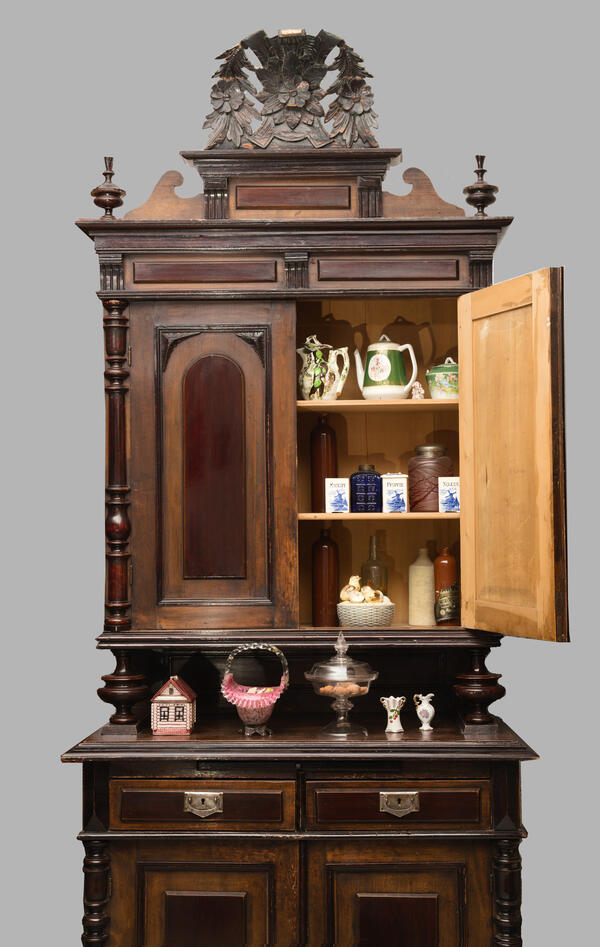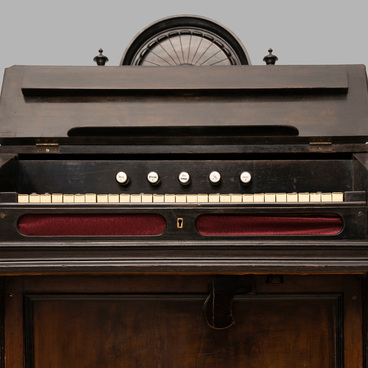The French word ‘buffet’ which is a Russian equivalent for cupboard is translated as ‘a table’. The French called the ‘buffet’ a cupboard where silver and porcelain dishes were kept. Since dishes were valuable items that required proper storage, the old cupboards had compartments. Certain types of tableware had their dedicated compartments. The cupboard doors were equipped with latches.
According to the recollections by a native Sarepta woman Hanna Nol, this cupboard was part of a set of furniture made in Sarepta after placing a special order for her father’s wedding. The church book of the Lutheran community of Sarepta has a record dated 15 June of 1908 (nineteen hundred and eight) and covering the marriage of Konrad Nol, a blacksmith from the sawmill, and Elizabeth-Catherine Kaltenberger from a poor large family. Konrad brought his wife to his father’s house, where his three brothers lived with their families. After a while, children appeared in the young family one by one.
After the publication of the Decree of the Presidium of the Supreme Soviet of the USSR ‘On the resettlement of Germans living in the Volga region’ dated 28 August 1941 (nineteen forty-one), the expulsion of
the Germans settled in the Volga region began. During the deportation, they were allowed to take personal belongings, small household equipment, money, and valuable item in the amount not more than one ton per family. People took the essentials with them: documents, clothes, and food.
Those properties that the Germans were not able to take were allowed to be sold. However, it was difficult to sell a house or property in a short time, so most of the things had to be abandoned. The Nol family was deported to Kazakhstan. The family had to leave their cupboard and other furniture.
In total, 2,409 people, or 664 families were deported from Sarepta. Partly, the Sarepta Germans ended up in eastern Kazakhstan, partly in Siberia, and the others arrived at Turkmenistan or the Urals. Then their destiny was work in the labour armies. These were special units from the deportees, where they were involved in hard forced labour.
In the 1950s, the deportees were allowed to return. When the Nol family returned to Sarepta, the first thing they did was to register with the local NKVD body (People’s Commissariat for Internal Affairs) and found their set of furniture in the house of the head of the service. Today, the entire set of the Nol family’s furniture is kept in the Old Sarepta Museum Reserve.
According to the recollections by a native Sarepta woman Hanna Nol, this cupboard was part of a set of furniture made in Sarepta after placing a special order for her father’s wedding. The church book of the Lutheran community of Sarepta has a record dated 15 June of 1908 (nineteen hundred and eight) and covering the marriage of Konrad Nol, a blacksmith from the sawmill, and Elizabeth-Catherine Kaltenberger from a poor large family. Konrad brought his wife to his father’s house, where his three brothers lived with their families. After a while, children appeared in the young family one by one.
After the publication of the Decree of the Presidium of the Supreme Soviet of the USSR ‘On the resettlement of Germans living in the Volga region’ dated 28 August 1941 (nineteen forty-one), the expulsion of
the Germans settled in the Volga region began. During the deportation, they were allowed to take personal belongings, small household equipment, money, and valuable item in the amount not more than one ton per family. People took the essentials with them: documents, clothes, and food.
Those properties that the Germans were not able to take were allowed to be sold. However, it was difficult to sell a house or property in a short time, so most of the things had to be abandoned. The Nol family was deported to Kazakhstan. The family had to leave their cupboard and other furniture.
In total, 2,409 people, or 664 families were deported from Sarepta. Partly, the Sarepta Germans ended up in eastern Kazakhstan, partly in Siberia, and the others arrived at Turkmenistan or the Urals. Then their destiny was work in the labour armies. These were special units from the deportees, where they were involved in hard forced labour.
In the 1950s, the deportees were allowed to return. When the Nol family returned to Sarepta, the first thing they did was to register with the local NKVD body (People’s Commissariat for Internal Affairs) and found their set of furniture in the house of the head of the service. Today, the entire set of the Nol family’s furniture is kept in the Old Sarepta Museum Reserve.



